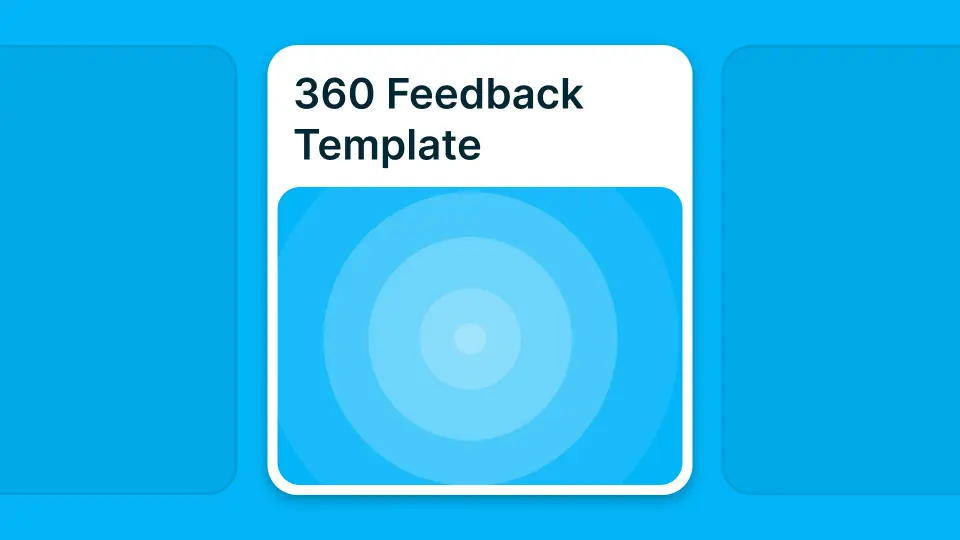Did you know that over 60% of companies using a 360 degree feedback template report faster leadership development? According to Gartner's 2023 research, organizations with structured feedback templates see measurably better outcomes than those using ad-hoc approaches.
If you want actionable, ready-to-use 360-degree feedback templates, you're in the right place. This guide gives you instant access to customizable questionnaires, rater matrices, and digital forms—plus expert advice on competencies, rating scales, and data privacy. You'll discover best practices for individual contributors, team leads, and executives, all shaped by international standards.
- Downloadable Word/Google Docs questionnaires for different roles
- Excel & Google Sheets rater matrices for easy data handling
- Google Forms for fast digital rollout
- Competency libraries (leadership, collaboration, DEI, more)
- Rating scales (3, 5, 7-point) and rater instructions
- Data privacy, anonymity, and works council guidelines explained
- Bias-mitigation strategies and calibration tips
- How AI tools like Sprad 360° & Atlas AI suggest smart questions and summarize results
Let's break down each step so you can launch feedback cycles with confidence—and avoid the most common pitfalls.
1. Choosing the Right 360 Degree Feedback Template for Your Organization
Selecting the right template is the foundation for effective 360-degree feedback. Templates should fit your company size, role types, and feedback culture. Without proper alignment, even well-intentioned programs fall flat.
Research by McKinsey shows 360 feedback programs are 30% more effective when templates are tailored to role level. Generic one-size-fits-all approaches create confusion and reduce participation rates significantly.
78% of HR leaders say using role-specific templates increases rater engagement, according to LinkedIn Talent Solutions' 2022 study. The difference becomes clear when you consider what matters most to each role level.
A mid-sized tech firm in Berlin rolled out different templates for engineers and managers. Before customization, participation rates hovered around 55%. After implementing role-specific 360 degree feedback templates, participation jumped to 82% within one feedback cycle. Engineers appreciated questions about technical collaboration, while managers valued leadership-focused competencies.
- Identify key roles: individual contributors, team leads, executives
- Match templates to core competencies per role
- Use flexible formats (Word/Docs, Sheets, Forms) for accessibility
- Align language and scale with organizational values
- Pilot with one team before full rollout
| Role | Template Type | Key Competencies | Format |
|---|---|---|---|
| Individual Contributor | Collaboration Survey | Teamwork, Communication | Google Form |
| Team Lead | Leadership Matrix | Coaching, Delegation | Excel Sheet |
| Executive | Strategy Questionnaire | Vision, Influence | Word Doc |
Consider integrating feedback templates with your performance management system for seamless data flow. This connection eliminates duplicate data entry and creates a more holistic view of employee development.
Once you've picked the right 360 degree feedback template structure, it's time to dig into the must-have competencies your feedback should cover.
2. Building Competency Libraries That Drive Real Development
Competency libraries ensure feedback is focused and actionable—covering skills that matter most for your business. Without clear competencies, raters often provide vague responses that don't translate into meaningful development plans.
SHRM reports that organizations using defined competency libraries see a 25% increase in actionable feedback quality. The structure helps raters understand exactly what behaviors to observe and evaluate.
63% of HR teams say lack of clear competencies leads to vague or unhelpful responses, according to SHRM's Benchmarking Report 2023. Comments like "good team player" don't help anyone grow.
A global retail chain revamped their 360 degree feedback template by adding a DEI competency cluster. Instead of generic diversity questions, they focused on specific inclusive behaviors. Within six months, inclusion scores improved by 18% across all management levels.
- Define core clusters: leadership, collaboration, communication, problem-solving, customer focus, DEI
- Adjust competencies per role and seniority level
- Use behavioral anchors for each competency
- Limit each survey to 6–10 core competencies for focus
- Regularly review and update your library based on business needs
| Competency | Sample Behavior | Applies To |
|---|---|---|
| Collaboration | Shares knowledge openly with team members | All roles |
| Leadership | Gives constructive feedback to direct reports | Team leads, Executives |
| DEI | Fosters inclusive culture in meetings | All roles |
| Communication | Explains complex topics clearly | All roles |
| Problem-solving | Identifies root causes before solutions | Individual contributors, Team leads |
Reference international frameworks like Korn Ferry or Lominger for inspiration—but customize for your context. What works in Silicon Valley might not fit a German manufacturing company's culture.
With your competencies mapped out, it's crucial to select the right rating scale to capture meaningful data from your 360 degree feedback template.
3. Selecting Effective Rating Scales and Rater Instructions
Choosing the right rating scale and giving clear instructions makes or breaks the usefulness of your results. Too many options confuse raters. Too few options lose nuance. The sweet spot varies by organization, but patterns emerge from the data.
According to Harvard Business Review, a clear scale increases rater accuracy by up to 40%. The key is providing behavioral anchors that remove guesswork from the rating process.
5-point scales are preferred by 67% of organizations for balancing nuance and simplicity, based on HBR's 2022 survey. This format gives enough range without overwhelming raters with too many choices.
An insurance company in Munich switched from a 3-point to a 5-point scale in their 360 degree feedback template. Rater confusion dropped by half, and managers reported more actionable insights from the expanded range.
- Decide between 3, 5, or 7-point scales (avoid "neutral" if possible)
- Provide examples for each scale point with behavioral anchors
- Give raters clear instructions on expectations and confidentiality
- Train raters on bias awareness before launch
- Include open comment sections for context
| Scale Point | Description | Example Behavior |
|---|---|---|
| 1 | Rarely demonstrates | Seldom shares information with colleagues |
| 2 | Occasionally demonstrates | Shares information when directly asked |
| 3 | Sometimes demonstrates | Regularly shares relevant updates |
| 4 | Often demonstrates | Proactively shares knowledge and resources |
| 5 | Always demonstrates | Consistently mentors and teaches others |
Interactive guides or short training videos can boost rater confidence significantly. A 10-minute explainer video showing how to use your 360 degree feedback template saves hours of confusion later.
Now let's look at how to implement these templates in practical formats—digital and offline options that work for any organization size.
4. Ready-to-Use 360 Degree Feedback Templates: Word, Google Docs, Excel & Forms
Accessible formats make it easy for any organization to start collecting structured feedback—no technical barriers or expensive software required. The right format depends on your team's preferences and technical setup.
Gartner found that organizations using digital forms process results up to 50% faster than those relying solely on paper or static documents. Automation eliminates manual data entry and reduces processing errors.
74% of respondents prefer Google Forms for ease of use in distributed teams, according to Gartner's HR Tech Pulse 2023. The mobile-friendly interface works well for remote and hybrid work environments.
A remote-first SaaS company moved from Excel-based surveys to Google Forms for their 360 degree feedback template rollout. Feedback completion rates increased from 61% to 89% within one quarter. The mobile accessibility made a huge difference for their global team.
- Download role-specific Word/Docs questionnaires for offline use
- Set up Excel or Sheets rater matrices for easy aggregation
- Launch Google Forms for anonymous digital collection
- Customize templates with your own competency library and scales
- Test on mobile devices to ensure accessibility
| Format | Best For | Pros | Considerations |
|---|---|---|---|
| Word/Google Docs | Small teams, offline use | Easy editing and customization | Manual data aggregation needed |
| Excel/Google Sheets | Data analysis, calibration | Bulk processing capabilities | Requires spreadsheet skills |
| Google Forms | Fast rollout, anonymity | Mobile-friendly, automatic collection | Limited customization options |
| PDF Templates | Consistent formatting | Professional appearance | Not easily editable |
Consider integrating with HRIS or performance management platforms for seamless workflow. Tools like Sprd offer pre-built 360 degree feedback template integrations that sync directly with your existing systems.
Next up—let's tackle privacy, anonymity, and works council requirements that often make or break feedback initiatives in European markets.
5. Ensuring Anonymity, Data Privacy & Works Council Compliance
Respecting data privacy and ensuring compliance with local regulations is non-negotiable for sustainable feedback programs. European organizations face particularly strict requirements that can derail initiatives if not addressed early.
A PwC study found that compliance issues are the number one reason why European companies pause or delay feedback rollouts. Legal challenges often surface months into implementation, forcing costly redesigns.
52% of German organizations cite Betriebsrat (works council) approval as a critical implementation step, according to PwC's HR Compliance Survey 2022. Involving employee representatives early prevents roadblocks later.
A manufacturing company in Stuttgart collaborated with their works council during 360 degree feedback template design. They co-created privacy guidelines and data handling procedures upfront. As a result, their program launched smoothly without delays or employee pushback.
- Inform participants about data handling with GDPR-compliant language
- Use anonymized forms whenever possible; avoid identifiers in open comments
- Involve the works council early in template design and process planning
- Store data securely with limited access rights and clear retention policies
- Clearly communicate who sees what results (individual vs. aggregated)
| Requirement | Action Step | Stakeholder | Timeline |
|---|---|---|---|
| GDPR Compliance | Use anonymized data collection | HR + IT | Design phase |
| Betriebsrat Approval | Share template drafts for review | HR + Works Council | 4-6 weeks pre-launch |
| Transparency | Communicate result access policy | HR + Employees | Launch communication |
| Data Security | Implement secure storage systems | IT + Legal | Technical setup |
Offer clear opt-out options and specify exactly how long data will be stored. Most organizations keep 360 feedback data for 12-24 months, then anonymize or delete individual records while preserving aggregated trends.
With privacy covered, let's explore how to interpret results from your 360 degree feedback template—and avoid bias in your analysis.
6. Calibrating Results, Mitigating Bias & Turning Feedback into Action
Calibration ensures fair results across different raters and departments. Bias mitigation makes insights actionable rather than misleading. Without these steps, your 360 degree feedback template generates data that looks scientific but lacks reliability.
Bersin by Deloitte found that uncalibrated results can skew promotion decisions in over 40% of cases. Some managers are naturally harder raters while others inflate scores—calibration evens the playing field.
Only 27% of organizations systematically calibrate feedback data, according to Bersin's Talent Analytics Report 2023. This gap represents a major opportunity for more accurate talent decisions.
A logistics provider in Hamburg used calibration workshops after collecting 360 degree feedback template results. HR facilitated sessions where managers compared ratings and discussed outliers. Inconsistent scoring patterns dropped by 35%, and resulting action plans became significantly more relevant.
- Run calibration sessions with HR and line managers to spot rating inconsistencies
- Use anonymized data when sharing results in group calibration meetings
- Train reviewers on common biases (recency effect, halo effect) before analysis
- Visualize data in dashboards for pattern recognition
- Link results directly to structured action planning sessions
| Bias Type | Description | Mitigation Step | Tool/Resource |
|---|---|---|---|
| Recency Effect | Rating based on recent events only | Mix review timing throughout year | Calendar reminders |
| Halo Effect | One trait influences all ratings | Train raters on objectivity | Short e-learning module |
| Groupthink | Raters influence each other | Anonymous scoring processes | Digital forms |
| Leniency Bias | Consistently high ratings | Calibration workshops | Manager training |
Automated summaries using AI tools like Sprd 360° & Atlas AI can flag potential bias patterns and suggest corrective actions. These systems analyze rating distributions and highlight anomalies that human reviewers might miss.
Ready to put your insights into action? Here's how to build follow-up plans that actually stick and drive behavioral change.
7. From Feedback to Growth: Action Planning & AI-Assisted Follow-Up
Feedback only drives change if it leads to concrete, measurable actions. Too many organizations collect detailed 360 degree feedback template data, then let insights sit unused in spreadsheets. AI-powered tools can now bridge this gap automatically.
Gallup shows teams with structured action planning after feedback improve performance by up to 23%. The key is translating insights into specific, time-bound development activities.
Teams using AI-generated summaries complete action plans in half the time compared to manual processes, according to Gallup's Workplace Analytics Report 2023. Automation handles pattern recognition while humans focus on meaningful conversations.
A consulting firm in Vienna used Atlas AI to auto-summarize individual results from their 360 degree feedback template process. Managers then co-created action plans in guided one-on-one sessions. Employee satisfaction scores rose by 21% within six months, with 89% of participants saying their development discussions were more focused than previous years.
- Schedule immediate debrief sessions within 2 weeks of sharing results
- Use template-driven action planning sheets with specific goal categories
- Leverage AI tools to highlight recurring themes and suggest relevant development goals
- Assign ownership for each action item with clear timelines and success metrics
- Schedule regular progress reviews in follow-up meetings
| Step | Tool/Template Used | Outcome Tracked | Timeline |
|---|---|---|---|
| Debrief Session | Guided agenda template | Shared understanding of results | Week 1-2 |
| Action Plan Draft | Google Sheets tracker | 3-5 specific development goals | Week 3 |
| AI Summary Review | Atlas AI dashboard | Focused priorities identified | Week 2 |
| Progress Check-in | Monthly review template | Goal completion status | Monthly |
Combine quantitative scores from your 360 degree feedback template with qualitative comments for richer development insights. Numbers show what needs attention; comments explain the why and suggest specific improvement approaches.
Sprd's integrated approach connects feedback collection, AI analysis, and action planning in one workflow—eliminating the typical gaps where insights get lost between systems.
Conclusion: Templates Are Just the Beginning—Continuous Feedback Drives Lasting Change
Implementing a successful 360 degree feedback template requires more than downloading forms and sending surveys. The organizations seeing real results combine smart template design with systematic calibration, bias mitigation, and structured follow-up.
Three key insights emerge from the data: First, tailored templates boost engagement and accuracy significantly—generic approaches consistently underperform. Second, competency-based questions combined with calibrated scoring unlock genuine development potential rather than just generating feel-good data. Third, compliance considerations, bias mitigation, and digital integration tools are now essential for trustworthy, scalable results.
Your next steps should focus on implementation rather than endless planning. Download templates that match your organization's role structure. Involve all key stakeholders—especially works councils in European markets—early in the process design. Set up calibration sessions and action planning cycles for every feedback round, not just the launch.
As AI continues reshaping HR analytics, expect smarter question recommendations, faster insight synthesis, and more personalized development suggestions. The future belongs to organizations that master the fundamentals while embracing technological enhancements that amplify human judgment rather than replacing it.
Frequently Asked Questions (FAQ)
What is a 360 degree feedback template and why do organizations use it?
A 360 degree feedback template is a structured form or questionnaire designed to collect performance insights from multiple sources—peers, managers, direct reports, and sometimes clients. Organizations use these templates to gain a comprehensive, well-rounded view of an employee's strengths and development areas. Unlike traditional top-down reviews, 360 feedback captures different perspectives, making development plans more objective and inclusive. The structured template format ensures consistency across raters and makes data analysis more reliable.
How do I choose the best rating scale for my company's feedback process?
The best rating scale depends on your organizational culture and feedback goals. Most companies find success with 5-point scales because they balance nuance with simplicity—enough range to capture meaningful differences without overwhelming raters. Avoid neutral midpoints when possible, as they encourage fence-sitting rather than thoughtful evaluation. Always provide clear behavioral definitions for each scale point so raters understand exactly what constitutes a "3" versus a "4" rating. Test your chosen scale with a pilot group before rolling out organization-wide.
Should my organization keep 360 degree feedback anonymous?
Anonymity generally encourages more honest, candid responses, especially when evaluating sensitive topics like leadership effectiveness or interpersonal skills. However, anonymous feedback can limit follow-up discussions and coaching opportunities. Most successful programs use anonymous collection for quantitative ratings while allowing optional identification for developmental comments. Consider your organizational culture—hierarchical environments typically benefit more from anonymity than flat, open cultures. Always communicate your anonymity policy clearly to build trust and participation.
How many raters should participate in each employee's 360 feedback review?
Aim for 6-10 raters per employee to ensure statistical reliability while keeping the process manageable. Include representation from different relationships: typically one manager, 3-4 peers, and 2-3 direct reports (if applicable). For individual contributors, focus more heavily on peer feedback. For executives, include a broader range of stakeholders. Having fewer than 5 raters makes the data less reliable, while more than 12 can create survey fatigue and reduce response quality. Quality of rater selection matters more than quantity.
What steps can I take to avoid bias in my 360 degree feedback template process?
Bias mitigation requires systematic attention throughout your feedback process. Start by training raters on common biases like recency effect (focusing on recent events) and halo effect (letting one trait influence all ratings). Use calibration sessions where managers compare ratings and discuss outliers to ensure consistency. Consider anonymous survey distribution to reduce influence between raters. Implement AI tools that flag unusual rating patterns, and always combine quantitative scores with qualitative comments for context. Regular process reviews help identify and correct bias patterns over time.












